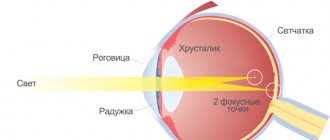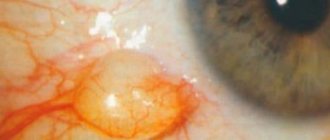Vision is one of the five senses that help a person perceive the world around him and navigate it well. The statistics are disappointing - the number of people with diseases of the visual system is growing every year. Now in Russia about 20.7 million people have various visual impairments. The most common are myopia, farsightedness and astigmatism.
Astigmatism is a refractive pathology, with the progression of which incoming light rays are not focused at one point on the retina. Prevalence – 13% among all vision pathologies. Diagnosed more often in men. Mixed astigmatism is one of the most complex and difficult to correct forms of this disease. This variety is characterized by the development of two visual dysfunctions at once - hypermetropia and myopia. Incoming light rays are focused simultaneously both in front of the retina and behind it.
The main symptoms indicating the development of mixed astigmatism include decreased visual acuity, distortion of the image or object in question, visual discomfort, and headache. If you have such symptoms, it is recommended to immediately visit a doctor. A specialized specialist involved in the diagnosis and treatment of pathologies of the visual apparatus - an ophthalmologist.
Diagnosis of complex astigmatism includes visometry, biomicroscopy, keratometry, and computer autorefractometry. Based on the data obtained, the degree of development of the pathology is determined and the most optimal treatment option is selected. Visual function can be restored with the help of glasses and special lenses. Surgery or laser correction is also possible.
What is astigmatism
This concept hides a disease of the visual apparatus, accompanied by the development of destructive processes in the cornea and lens.
Their ability to refract is impaired. As a result, it is not a clear picture that gets onto the retina, but an image with blurry contours. The disease is accompanied by severe headaches, diplopia and rapid eye fatigue even with light exertion. The following medical procedures are used to diagnose the disease:
- Visometry. Used to test visual acuity. The patient is put on a trial frame, in which one eye is closed, and in the second, the clarity of the image is corrected using different lenses. Astigmatism, most often, comes “in company” with myopia and farsightedness;
- Skiascopy. A technique for determining the refraction of the organ of vision, which is based on observing the movement of shadows in the area of the pupil when a light flux hits it;
- Biomicroscopy. Helps analyze the condition of the cornea;
- Ultrasound examination of the organ of vision;
- Computer keratotopography. Measurement of the degree of refraction at a large number of points;
- Ophthalmoscopy. Fundus examination using a slit lamp.
| Detailed diagnostics allows you to make a correct diagnosis and discover the cause of the pathology. |
How does mixed astigmatism manifest?
Only a doctor can identify mixed astigmatism. But you can suspect the presence of pathologies of the visual apparatus based on the following signs:
- eyes get tired very quickly;
- visual acuity decreases;
- there is a feeling of pressure in the eyes;
- surrounding objects have distorted outlines, they are blurred;
- It is difficult for a person to determine at what distance from him this or that object is located;
- headache or dizziness often occurs;
- bright light can cause discomfort or even pain;
- objects in the field of vision bifurcate;
- a person blinks frequently because he has the feeling that a grain of sand has entered his eye;
- periodically a veil appears before the eyes;
- vision is poorly focused.
Symptoms worsen if a person tries to read small print. In addition, vision worsens in the evening and at night. Some note that glare appears in the eyes.
How is astigmatism corrected with laser?
Surgery using laser techniques aimed at correcting astigmatism is the most progressive method of vision restoration. The result of the surgical intervention can be assessed within a few hours after the operation - the new profile of the cornea, formed using a laser, allows you to see images clearly, without distortion.
Currently, there are a number of techniques that can correct astigmatism: SMILE, FemtoLASIK, LASIK, etc. The choice of technique depends on the characteristics of the patient’s cornea and the capabilities of the clinic where the operation is planned. If the condition of the cornea does not allow laser surgery, the patient may be offered phakic lens implantation.
Ophthalmologists advise patients who have undergone surgery not to forget about preventive measures to prevent the development of myopia and astigmatism, because the laser only corrects the defect, but not its cause.
To ensure that the effect of the operation lasts for many years, you should regularly perform eye exercises by choosing the appropriate technique.
How to recognize symptoms of astigmatism in children
In a child under three years of age, vision problems can be suspected or identified by performing a simple test. One adult takes the child in his arms and alternately closes one or the other eye.
The second adult sits opposite and attracts the baby’s attention with the help of bright toys. A sharply negative reaction - crying, lifting your hand from a closed eye - may indicate that the open eye sees worse than the closed eye
Parents can also pay attention to other symptoms of vision loss. For example, if a baby fails to pick up a toy, he misses the target with his hand - after all, one-year-old children with normal vision can complete such a task the first time
At an older age, parents may suspect astigmatism if they notice that their son or daughter tilts his head or squints his eyes when looking at an image. Often stumbles or stumbles when walking, has difficulty focusing on printed text, and pulls the outer corner of the eye with a finger
It is worth paying attention to the child’s reluctance to look at pictures, draw, study letters, read books, because it is difficult for him to fix his gaze on an object or text
Children may also complain of poor vision near or far, distortion of visible objects, visual fatigue, eye fatigue and irritation, headache after visual stress, double vision.
But since babies adapt well to deteriorating vision, there may be no subjective signs of refractive error. Therefore, examinations by a pediatric ophthalmologist play an important role in identifying astigmatism.
The benefits of visual gymnastics
Exercises for astigmatism cannot be considered as a salvation from the anomaly. One exercise cannot restore the health of your visual organ, unless you have a mild degree of illness. Gymnastics goes in combination with drug therapy, increasing its effectiveness and accelerating the healing process.
Simple exercises take a little time, but they give amazing results. They can be performed in any conditions, since they do not require additional equipment or special equipment. Exercise relieves tension and fatigue from the eyes, strengthens the visual apparatus.
If you do gymnastics on a regular basis, the tension will go away from the eye muscles, and the symptoms of the disease will become less pronounced. This allows you to block the development of anomalies and normalize visual acuity.
Today, there are many different methods for restoring eye health using a set of exercises. Some ophthalmologists claim that gymnastics really helps change the shape of the eyeball. This will help get rid of astigmatism, myopia and hypermetropia without the help of a surgeon. However, doctors do not officially confirm such a statement.
Gymnastics for the eyes for astigmatism helps relieve fatigue and reduce the level of stress on the weakened organ of vision, but it is not able to correct the mechanism of development of the pathology. Doctors recommend regular exercise for people who have ophthalmic problems due to improper functioning of the muscles. In cases of refractive error, the effect of exercises is minimal.
| The decision about whether to perform gymnastics or not should be made together with the doctor. In severe forms of astigmatism, exercise is contraindicated for many patients, as it can worsen the patient's condition. |
Return to contents
Diagnostics
Clinical researches
The examination begins with a trip to the ophthalmologist. And the first, standard procedure is a vision test. Scientifically it is called viziometry. The nurse shows letters (drawings) on the table and depending on how many lines the patient sees, the percentage of vision is determined.
Next, lenses with the required diopter are selected. The only caveat is that children are tested according to these tables from the age of four. Even if he speaks well and can name objects, experts refuse to use tables at an early age in order to eliminate errors caused by pampering or misunderstanding of the child.
Skiascopy (examination in a dark room) is also a common procedure. It is needed to study how light is refracted when passing through the patient’s pupil. It is likely that every reader has undergone this examination, so we will not dwell on it for too long.
If vision problems have been detected, further diagnosis must be carried out. Fortunately, there are now a sufficient number of medical ophthalmological centers, both private and public. To clarify the diagnosis and determine treatment tactics, the following studies are recommended.
Biomicroscopy
This is a careful examination of the eye under a microscope. As a rule, the procedure does not cause discomfort. People with photophobia may experience pain.
The patient places his chin on a special stand, then, resting his forehead on the top of the device, opens his eyes wide. An ophthalmologist directs a beam of light onto the eyeball and, using multiple magnification, examines the organ, looking for the cause of the pathology.
Refractometry
Refraction (the ability to refract light correctly) is studied. You need to prepare for the examination in advance. Use special atropine drops for three days. It is important to remember that the dosage depends on the age and characteristics of the person, so only a doctor should prescribe them. And an equally important point: the product dilates the pupils, so visual stress (reading, computer TV, etc.) should be avoided. After the preparatory stage, the procedure itself takes a few minutes. The patient's head is fixed on a special stand, after which the doctor directs an infrared beam of light onto the retina. The results obtained are processed by a computer.
Ophthalmoscopy
Study of the retina, fundus, optic nerve. The procedure also makes it possible to examine the condition of the blood vessels in the organ. Before the procedure, the doctor dilates the pupils using special drops. The process itself takes up to five minutes, but the results help diagnose a large number of pathologies.
Computer keratotopography
A special laser examines the cornea and transmits data to a computer. The result is a kind of map indicating problem areas and healthy areas.
Return to contents
Tests at home
You can check for astigmatism and hypermetropia in adults and children at home. For this use:
- Siemens star
- Dark lines
- Lines
The point of the examination is that the child looks at a special drawing first with one and then with the other eye. If he sees images differently, there is reason to suspect something is wrong and make an appointment with an ophthalmologist.
Despite their popularity and simplicity, these tests cannot be considered reliable. After all, errors are possible during the procedure, due to the fact that the baby cannot always adequately explain his feelings. The method is more suitable for adults and children over ten years of age.
Description of the disease
You can understand the seriousness of the problem by knowing what it is. The disease is a visual dysfunction caused by an abnormal shape of the cornea or lens of the eye. In a healthy state, a beam of light is focused at only one point on the retina. With astigmatism, there may be several such points. Because of this, the image is blurred and appears unclear. A slight degree of astigmatism - up to 0.5 diopters - is present in the majority of the world's population. But this indicator is not considered anomalous, since it does not lead to image distortion. Curvature of the organs of vision by more than 1 diopter requires therapeutic measures.
Types and degrees
In ophthalmology, there are two forms of mixed astigmatism - acquired and congenital. They differ depending on the etiology (the reasons that provoked them). The acquired form is more common in the adult population of the country.
Experts also define five types of astigmatism:
- simple hypermetropic.
In this case, farsightedness of one meridian is noted, while the refraction of the second is not changed; - complex hypermetropic.
The normal refraction of the main meridians is impaired - they are farsighted to varying degrees; - simple myopic.
An incoming ray of light travels normally along one meridian and is focused on the retina, and along the second it is focused in front of it; - complex myopic.
In this case, myopia is noted along two meridians at once; - mixed.
Along one meridian, the incoming light beam is focused behind the retina, and along the second - in front of it.
The disease is also divided according to severity. This facilitates diagnosis and helps select a treatment method.
- Weak degree
- up to 3 diopters. The most common. It responds well to treatment with both conservative and surgical methods. It is best to resort to laser vision correction. - The average degree
is from 3 to 6 diopters. Diagnosed somewhat less frequently than weak. There is no way to correct it with glasses. Visual function can be restored using special lenses, surgery or laser correction. - High degree
- over 6 diopters. Develops as a result of gross changes in the cornea of the eye. In this case, correction means such as glasses or contacts must be combined with surgery and the use of a laser.
It is easiest to restore visual function when the optics of the eye are not yet significantly changed. When the first symptoms appear that indicate a decrease in visual acuity, it is important to see a qualified ophthalmologist.
Is it possible to cure astigmatism with exercises?
According to doctors, the health of the visual apparatus is directly related to the condition of the body as a whole. Therefore, do not consider gymnastics as a panacea for all ills. In addition to regular charging, follow these simple rules:
- Sleep at least eight hours a day;
- Lead an active lifestyle;
- Balance your diet;
- Walk more in the fresh air;
- Follow a daily routine;
- Adjust the level of eye strain.
It is possible to get rid of the pathology if the patient, in addition to gymnastics, uses corrective optics, constantly attends physical procedures and adheres to all the recommendations of the attending physician.
Diagnosis of mixed astigmatism
At the appointment, the ophthalmologist will conduct an examination and listen to the patient’s complaints, after which he will prescribe additional instrumental diagnostic methods. Assessing the condition of the organs of the visual apparatus and identifying disorders allows you to:
- visometry;
- tonometry;
- biomicroscopy;
- shadow test (to determine the refractive power of the cornea);
- examination of the fundus with a wide pupil;
- Corneal surface CT;
- Ultrasound of the eyes.
These methods allow you to accurately make a diagnosis and determine the degree of development of the pathology. Based on the data obtained, the doctor will be able to offer the best option for vision correction.
Types of astigmatism in children
Astigmatism occurs against the background of pathological changes in the lens or cornea; it can be nearsighted or farsighted astigmatism in children. Therefore, it has several types, depending on the location of the focus:
- A simple form is myopia or farsightedness of one organ.
- A complex type is the presence of farsightedness/myopia in different eyes and with varying degrees of severity.
- A mixed type of astigmatism is when one organ is nearsighted and the other is farsighted.
Causes
In children, astigmatism can be acquired or congenital. With a hereditary factor, a child is born with an already changed lens or cornea, and an acquired one appears due to the following reasons:
- Injury to the visual apparatus.
- Consequences after eye surgery.
- Presence of infectious diseases.
- Diseases of the eyes and in particular the cornea, after which scars have formed.
- Pathology of the dental system.
Symptoms of astigmatism in children
If the child is too young, he or she is unlikely to complain of any symptoms, but special attention should still be paid to the behavior at any age. So, signs of astigmatism in children:
- Double vision when looking at pictures/reading books.
- Blurry images.
- Rapid eye fatigue.
- Dizziness and pain in the head.
- Inability to focus your eyes when reading.
- Squinting of eyes.
- Tilts of the head in different directions when trying to look at an object.
Reasons for the development of mixed astigmatism
The etiology of this disease has not yet been fully established. It is classified as a hereditary pathology. This suggests that if mixed astigmatism is diagnosed in one of the parents, then it is highly likely that it will be passed on to his children. It is also possible that the disease can develop as a result of developmental anomalies in the prenatal period, as well as due to poisoning of the fetus with alcohol breakdown products (if the mother regularly drank alcohol during pregnancy). The congenital form of the pathology is usually detected in childhood.
The acquired form of mixed astigmatism develops in individuals who do not have a family history. Visual function is impaired under the influence of unfavorable exo- and endogenous factors.
Reasons for the development of the acquired form of the disease:
- trauma to the organs of vision or the skull as a whole;
- development of inflammatory processes in the cornea;
- previous eye surgeries;
- keratoconus;
- Salzmann's nodular degeneration;
- keratitis.
Under the influence of certain unfavorable factors, the surface or shape of the cornea of the eye changes. Its curvature becomes uneven along the vertical and horizontal meridians. Incoming rays are refracted incorrectly, and focusing will occur at several points at once. As a result, a person sees objects blurred, distorted, without clear outlines.
Pre-palming
To relax the visual muscles, perform the palming technique, developed by the American scientist William Bates. The essence of the exercise is as follows: place your palms on your closed eyes, the heat from them dilates the blood vessels, increasing the amount of oxygen supplied to the organ of vision.
Palming is performed in a relaxed state. Sit or lie down in a comfortable position, rub your palms to warm them up. Place them in a “house” shape on your closed eyelids. Try not to allow light to reach your eyes. Sit like this for five minutes.
Recommendations for performing exercises
Recommendations and exercises must be followed for any visual impairment, as well as for the prevention of eye diseases.
Comprehensive compliance with the following conditions will be the key to obtaining a positive result from eye gymnastics for astigmatism:
- General muscle relaxation (physical relaxation);
- Mental relaxation;
- Proper breathing and diet (nutrients and oxygen supplied through the blood to the eyes ensure their proper functioning).
Sets of exercises for astigmatism
Charging consists of several movements. To work with the internal muscles, it is recommended to perform gymnastics aimed at defocusing the gaze. There is nothing complicated about it, you just need to focus first on a nearby object, and then on what is located at a distance. If there are no suitable objects for training around, the index finger will come to the rescue. First, move it close to your face, and then remove it as far as possible.
The muscles of the eyelids deserve special attention. Squeeze them tightly, and then open your eyes wide. Repeat several times. All techniques included in the complex must be performed five to ten times. Blink vigorously for a few seconds between each set. Return to contents
Bates method
It is used not only to eliminate astigmatism. The famous ophthalmologist and scientist William Bates developed a unique gymnastics that helps restore vision and get rid of many ophthalmic diseases. If you perform the complex regularly, you will be able to avoid surgical intervention and forget about corrective optics. William was sure that his vision problems were directly related to stress.
- The initial stage of gymnastics will be performing the “Palming” technique. It relaxes the visual apparatus, and the warmth from the palms activates blood circulation;
- At the next stage, perform the “Solarization” exercise. It will require any light source, it could be a candle, the sun or a flashlight. It is better to carry out solarization in the fresh air. Take a position so that when you turn your head in one direction, the light hits your eyes, and when you turn in the opposite direction, they find themselves in the dark;
- Start blinking, open and close your eyelids intensively. Then roll your eyes, first clockwise, then counterclockwise. The technique is performed at a slow pace, movements should be smooth;
- The Bates complex also includes the figure eight and snake exercises.
After watching the video, you will understand how to perform gymnastics correctly from an American doctor.
Exercises according to Zhdanov’s recommendations
The main purpose of exercise is to relax the muscles of the organ of vision. If you wear glasses, they do not need to be removed during exercise. All movements should be smooth, without sudden jerks. The Russian professor advises repeating the techniques three to five times, after each approach you need to blink intensely for several seconds.
From the video you will learn what exercises are included in the Zhdanov complex and how to perform them correctly.
Gymnastics according to Avetisov
One of the most common methods. It includes three groups of exercises. They also bring results in adults, but are most effective when treating young patients:
- The first complex includes techniques whose main purpose is to activate blood circulation and normalize the circulation of intraocular moisture. It includes the following exercises: “closing and opening the eyelids”, “movement in a circle”, “pressing on the eyeballs”;
- The second group combined techniques that help relax the muscles of the visual apparatus and strengthen weakened muscles. Includes a series of gaze movements: “from top to bottom and in the opposite direction,” “in a circle,” “diagonally,” “vertical and horizontal figure eight”;
- The third group consists of techniques aimed at strengthening accommodation. Place one object close to you, and the second at a distance. Slowly move your gaze from one object to another. You can also use your index finger, placing it at a palm-length distance from your nose. Bring it as close to your face as possible, and then slowly remove it. In this case, the gaze should be focused on the finger.
Return to contents
Norbekov method
First you need to relax the muscles of the eyes using the techniques described above. Then blink quickly and start performing the complex:
- Draw a figure eight in the air. Move first clockwise, then counterclockwise;
- Similarly, create a figure eight that is in a “lying” position;
- Visually draw a circle, moving clockwise, then counterclockwise;
- Place your index finger at a distance of thirty centimeters from your face. Close one eye and focus the other on your finger. Then look at an object located in the distance. Then repeat the exercise with the other eye.
| Each technique must be performed five times. At the end of the exercise, lie down for five minutes with your eyelids closed and relax. |
Tibetan gymnastics for the eyes
It is very popular because it is highly effective:
- The first exercise is aimed at working with the internal muscles of the organ of vision. Place your palms in front of your face at a distance of forty centimeters. Slowly separate them and bring them together. Try to keep your palms in your field of vision as much as possible, while your head should remain motionless;
- The next technique is aimed at accommodation. Focus your gaze on your hand extended forward. Then move your gaze to an object in the distance. Blink quickly and make rotational movements for two minutes;
- At the end of the gymnastics, perform a light eyelid massage. Be very careful and avoid applying too much pressure. All manipulations are carried out using the fingertips.
Each technique must be performed five to ten times.
Gymnastics for children with astigmatism
Remember that kids should be interested in doing the exercises. Therefore, they are most often carried out in a playful way to captivate children. Otherwise, the results from gymnastics will be minimal.
Before starting exercises, you need to relax the muscles of the eyes; all exercises are performed daily to achieve maximum effect:
- "Butterfly". Ask your child to imagine a beautiful insect flapping its wings and encourage him to blink his eyes as well.
- "Happy Hours" The baby should imagine that his organ of vision is the hands of a clock. Ask to see what time it is. Thus, he will move his eyes in different directions;
- "Blind Man's Bluff." You need to close your eyelids. Can be played in the form of a game of hide and seek;
- "Traffic light for trains." Ask the child to close his eyes one by one, first the left one, then the right one;
- "Peepers." You need to look at the object for as long as possible, but you are not allowed to blink;
- "Far close". Ask your baby to look for objects located at different distances;
- "Massage". The final stage of charging. Invite children to gently stroke their eyelids, eyebrows, cheekbones and eye sockets. At the same time, you need to say: “Thank you for the perfectly performed exercises.”
After watching the video, you will understand how you can have a fun physical activity for your child.
Return to contents
Treatment of the disease
Source: ymadam.net
Every parent should remember that the sooner mixed astigmatism is identified and treatment begins, the better. The disease cannot be neglected; this can lead to severe deterioration of vision, which will be much more difficult and impossible to correct in the future without surgical intervention.
Mixed astigmatism in children is treated. Moreover, with timely and competent therapy in the future, the child may not need lenses and glasses and will be able to lead an absolutely normal life.
If the violation is no more than 0.5 diopters, no special treatment is required. The child does not experience any difficulties or discomfort, so only regular monitoring by an ophthalmologist is recommended.
In case of serious visual impairment, correction is mandatory and includes:
- wearing glasses or contact lenses;
- medicinal methods;
- special exercises;
- surgical methods.
Mixed astigmatism is the most difficult form of the disease to treat. The correction is aimed at increasing visual acuity along the leading meridian and suppressing the image along the secondary one.
Since the development of mixed astigmatism in children is based on the abnormal development of the eyeball, complete recovery from this pathology can only be achieved surgically.
However, ophthalmologists resort to surgical techniques in extremely rare cases with malignant progression of the disease.
In most clinical cases, it is possible to achieve normalization of the visual function of a child’s eyes as a result of the use of corrective techniques:
- individual selection and constant wearing of glasses and contact lenses;
- hardware treatment methods (using specially developed computer programs);
- performing special gymnastics for the eyes.
Additionally, physiotherapy methods (electrophoresis) can be used for therapeutic purposes, the effect of which is aimed at stimulating inactive areas of the retina.
Provided early detection of the disease and timely initiation of therapeutic measures, most children can achieve normal vision by 12-14 years.
If, for one reason or another, astigmatism was detected in a child over 4-5 years of age, the duration of treatment is slightly increased. However, many patients eventually regain their vision and no longer need glasses.
Thanks to technological progress and the invention of the latest ophthalmological equipment, normalization of the refractive abilities of the eyes and restoration of vision can be achieved in all patients. The main condition for this is a visit to an ophthalmologist and strict adherence to all his recommendations.
Glasses
The easiest way to correct it. Regulation of optical power along different meridians is achieved by a complex system of spherical and cylindrical lenses. However, it is unlikely that you will be able to achieve 100% vision. In addition, the frame interferes with side vision and narrows the field.
Psychological discomfort is also an important factor: among peers, a child wearing glasses may be teased. A high degree of amblyopia is a contraindication for wearing glasses.
If the difference in visual acuity in the two eyes is significant, then with this method of correction severe dizziness, headaches and nausea are possible.
Disadvantages of glasses:
- limited perception of space and defects in lateral vision;
- you cannot engage in physical education and active sports;
- heavy, uncomfortable design;
- it will never be possible to perfectly restore visual capabilities;
- with a poor selection of glasses, vision sharply decreases, severe migraines torment;
- children under three years old do not want to wear glasses or constantly forget, children from 7 years old begin to have complexes, and because of this, difficulties begin.
Contact lenses
This type of treatment for astigmatism is used in older children and adolescents. The operating principle is the same as for glasses. They are unable to completely cure astigmatism; they only correct visual acuity.
However, unlike glasses, lenses do not limit the field. Most modern pairs are completely safe and easy to use. Irritation of the mucous membrane or allergic reactions are observed in rare cases.
Drug treatment
The use of medications for astigmatism does not affect the outcome of the disease in any way and is considered auxiliary. Eye drops are used to moisturize the mucous membrane, relieve irritation and swelling, and fight associated infection.
The use of ophthalmic medications is recommended during the rehabilitation process after surgery.
Surgical operations
The main method of treating astigmatism is surgery. Only correction of the optical curvature of surfaces allows the normal image on the retina to be restored. However, such methods can be used no earlier than 16 years of age, since the child’s body grows and changes.
Indications for surgical intervention:
- high degree of astigmatism;
- impossibility or low effectiveness of correction;
- rapid progression;
- There is a big difference in visual acuity in the right and left eyes.
Microsurgical or laser operations are performed. The first group of interventions includes keratotomy (making small incisions to reduce curvature) and keratocoagulation (cauterizing part of the cornea).
These methods require preliminary preparation, general anesthesia, and are painful. The rehabilitation period after surgery is long, and the possibility of secondary development of astigmatism due to scar changes after surgery remains high.
Laser correction methods are more effective. They are painless, take a minimum of time, are performed under local anesthesia, and the recovery period is several days.
Laser keratomileusis is more often used - evaporation of the underlying layers under the cornea in order to create a regular spherical surface. Most often, children and adolescents with mixed astigmatism are prescribed laser correction.
A simple, safe and painless procedure that has a high level of effectiveness. If laser correction is carried out correctly and in a timely manner, then an almost 100% positive result can be guaranteed.
Even if mixed astigmatism is diagnosed in both eyes, laser correction can help get rid of the pathology. The essence of the method is that in order to correct this form of pathology, it is necessary to increase the optical power of the eye in one meridian and decrease it in the other.
In the first meridian, the surface of the cornea is made more convex by removing tissue from the outer (peripheral) layer of the cornea. While in the second meridian, the surface of the cornea is made flatter by removing tissue from the central zone of the cornea.
Using a microkeratome instrument, the surgeon cuts off part of the surface layer of the cornea (flap) and turns it away to gain access to the middle layers of the cornea. Under the influence of the laser, specified areas of tissue in the middle layer of the cornea are evaporated.
This allows you to give it a smooth spherical shape, the parameters of which are individual for each patient. After the procedure is completed, the flap is returned to its place.
Laser correction also has its contraindications; they must be taken into account. The operation cannot be performed if:
- the presence of inflammatory processes;
- dystrophic changes in the retina;
- infectious diseases;
- reduced immunity.
Such contraindications are temporary, and if laser vision correction is unavoidable in this particular case, then the doctor simply rescheduled the procedure for a more appropriate time.
In some cases, laser correction may not be effective and astigmatic keratotomy may be prescribed. The essence of the method is the application of micro-notches on certain meridians.
This procedure is rarely prescribed to children and adolescents, since its future results are difficult to accurately predict. Moreover, the procedure itself is painful, and the recovery process is quite long.
Sometimes more radical operations may be prescribed - lens replacement, implantation or corneal transplant. The most appropriate method is selected only by a specialist and only after a complete thorough examination.
Treatment of astigmatism in children
Many people believe that childhood astigmatism can go away on its own over time. Yes, there is some truth in this, but measures must be taken to achieve this. Moreover, the success of treating astigmatism depends on the degree of the disease and timely diagnosis. Therefore, if you notice the slightest symptoms, immediately take your child to an ophthalmologist who will make the correct diagnosis.
So, astigmatism in children: can it be treated or not? Without fail, but not with medication, because this disease is not an inflammatory process. Today there are a huge number of techniques, and many of them simply need to be used in combination.
Glasses
Glasses are used as a gentle method of vision correction, which is why they are the most common and in demand. Special cylindrical and spherocylindrical glasses are inserted into glasses, which help get rid of astigmatism. Unfortunately, children do not really like to wear them and take a long time to get used to them. So, in the first weeks, complications such as tearing, dizziness, headaches and visual discomfort may occur. As a rule, a child’s body begins to get used to glasses after a week or two.
But if this does not happen, you should immediately go to the hospital. There is a possibility that these particular glasses are not suitable for your child. Then the doctor will replace them with others. Please note that not only the glass is selected, but also the frame. Make sure that the child is comfortable, namely, that the frame is not too large or small, and that the weight does not put strain on the face. The disadvantages of this technique include the lack of lateral gaze, and this interferes with everyday life.
Contact lenses
Treatment of astigmatism in children may involve wearing specific lenses. They are called toric. Unlike glasses, lenses do not limit side view and general perception (peripheral vision), the child does not feel embarrassment or discomfort. In this way, the correct development of the centers of vision occurs. This makes lenses preferable to glasses. But there are pitfalls here too. For example, lenses require careful care and respect. In addition, there is an age limit, so they are not suitable for children. And finally, it also takes time to get used to.
Diagnosis of the disease
Astigmatism is diagnosed due to decreased vision or due to an unknown cause of headache, fatigue and other possible symptoms. Also, children who are not doing well in school are usually referred for an vision test. Depending on the reason for the visit, the sequence and choice of diagnostic methods may vary, but the main ones are:
Eyesight check
- visometry – checking the clarity of vision
- fundus examination and intraocular pressure measurement
- Ultrasound of the eye
- ophthalmometry – determination of corneal curvature
- autorefractometry
Thinning of the retina: diagnosis, treatment with drugs and vitamins
All these measures make it possible to accurately determine the correct diagnosis of complex hypermetropic astigmatism in a child, as well as determine its degree.
Diagnosing the disease and accurately determining the degree of severity is possible only in the office of a specialized specialist - an ophthalmologist using special equipment.
Doctors' opinions on the use of gymnastics
According to ophthalmologists, exercise for the organ of vision effectively eliminates tension and relieves fatigue from the eyes. With their help, you can achieve maximum relaxation of the eye muscles. In addition, gymnastics is an excellent prevention of the development of ophthalmic diseases.
If you do the exercises on a regular basis, spend ten minutes a day on it, then your visual acuity will remain until adulthood.
If there are deviations in the functioning of the visual apparatus, exercise is an integral part of therapeutic therapy. In some cases, the pathology continues to develop even after surgery. This is observed if the visual muscles do not work.
| To eliminate the risk of relapse or deterioration of well-being, you should regularly perform simple exercises. If possible, do the exercises several times throughout the day. |
Causes and types of strabismus
True strabismus is not always a congenital pathology. During the first 3 years, when binocular (3D) vision is actively developing, the following reasons lead to the appearance of an asymmetrical gaze:
- congenital farsightedness or myopia - the difference in refraction between the right and left eyes;
- diseases of the central nervous system: cerebral palsy, brain tumor, etc.;
- severe stress: bruise, fright, vaccination, acute respiratory viral infection or other viral disease.
Normal operation of both eyes produces two images; the visual analyzer combines them into one and forms a three-dimensional image. With strabismus, the images fail to connect and the brain ignores what the squinting eye sees. His visual acuity gradually decreases, lazy eye syndrome may develop, he stops moving and perceiving objects. The child develops a flat image of the world. Established pathology is difficult to correct, so it is important to start treatment on time.
If there are cases of hereditary strabismus in the family, parents should regularly check the child's vision in the first three years.
Dr. Komarovsky emphasizes that in the period up to 3 years, any injury can provoke heterotropia, and at this time, hidden strabismus, invisible in a newborn, progresses. Therefore, visits to the ophthalmologist should be mandatory at 2, 6, 12
months, and then once a year until school age.
In total, there are about 25 types of strabismus, the formation mechanism of each of them is different, and, therefore, the treatment methods are different. Based on the displacement of the visual axes, 4 types of strabismus are distinguished.
- esotropia - convergent strabismus, when the eyes converge on the bridge of the nose, this deviation occurs with congenital farsightedness;
- exotropia - divergent position of the eyes, when the ocular axes are shifted towards the temples, this type is characteristic of myopia;
- vertical heterotropia - displacement of the visual axis up or down.
Prevention
Congenital astigmatism cannot be prevented using preventive measures. In this case, secondary prevention - timely examination by a specialist - will be more relevant. Constant monitoring will prevent the development of pathological complications and vision deterioration. The following measures will help you avoid congenital astigmatism:
- alternating periods of visual tension with rest;
- proper organization of the child’s workplace;
- sufficient lighting of the room and workplace;
- doing eye exercises every day.
If a child has a predisposition to the disease, then he may be prescribed physiotherapeutic procedures, for example, pneumomassage.
Mixed type astigmatism, treatment featuresSymptoms of astigmatismWhat is astigmatism and how is it treatedImproving vision with astigmatism with exercises
What symptoms should parents be wary of?
Pay attention to how your child looks at objects. Children should not squint or tilt their heads in different directions to better see the picture. With astigmatism, they will not be able to look straight because the object will appear curved to them. The baby will begin to complain of headaches and burning eyes. Fatigue and aggression appear. He refuses to draw and read, and his performance decreases. If you have such symptoms, you should not put off visiting an ophthalmologist for too long.
Norbekov method
You must first prepare as described above. You should blink first.
- Next, draw the number eight with your eyes in one direction, then in the other.
- Then, in the same way, draw the lying number eight with your eyes.
- Then we visually draw a circle clockwise, then counterclockwise.
- Place your index finger at a distance of 25-30 cm from your face. We close one eye, focus the second on the finger, then on a distant object. Next, repeat in the same way with the other eye.
All exercises are performed five times. After the entire complex, it is recommended to sit (or lie down) with your eyes closed for five minutes and relax.










